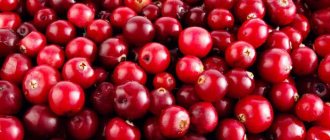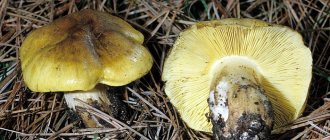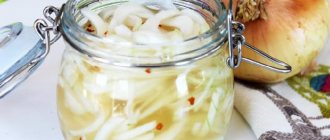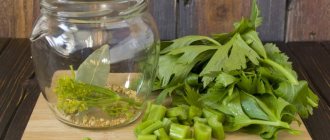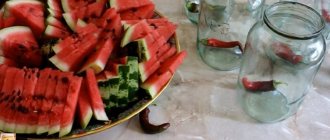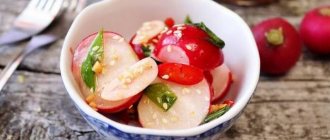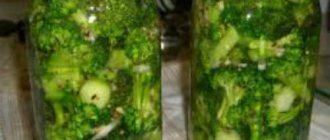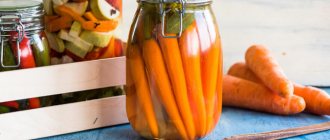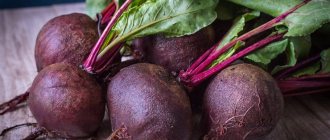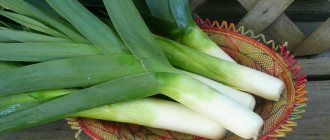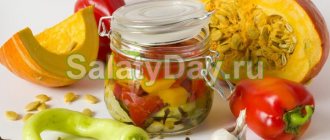Parsley is traditionally prepared for the winter by drying. This seasoning can most often be found on market shelves: it is used to prepare parsley soup in winter. But homemade preparations with this aromatic healthy herb are much more varied. Here you can find ice cubes, which are used to prepare green salads in winter, and pickled leaves, which preserve all vitamins, and caviar twisted with garlic and other spices and vegetables - and much, much more, no less appetizing than fresh parsley. Such preparations help us get rid of the symptoms of vitamin deficiency in winter and simply make dishes tastier. If you eat parsley correctly, it will supply our body with microelements and vitamins, which are so lacking in winter.
Classic recipe for parsley with salt in a jar
Parsley prepared in the classic way with salt is easy to store. The jars do not take up much space, the contents do not ferment, the aroma and color are preserved, and most importantly, the greens can easily withstand the whole winter.
Parsley for the winter in the form of preparation. Classic recipe
What ingredients will you need?
For the preparation you need to take:
- parsley – 300 g;
- rock salt – 100 g.
Step-by-step cooking process
The cooking process includes several stages:
- It is necessary to thoroughly rinse the parsley so that no soil fragments remain on it.
- Next you need to trim the roots, if any. Using a sharp knife, carefully chop the greens.
- As you chop the parsley, it is recommended to transfer it to a deep container, evenly sprinkling it with coarse salt. When the ingredients run out, you need to mix the contents of the container thoroughly.
- Then you need to transfer the greens with salt into jars and compact them well.
- Next, you should put the filled jars in the refrigerator for 1-2 days. There is no need to close the jars with lids.
- After waiting the specified time, you need to remove the jars from the refrigerator and compact the contents tightly again. For better compaction, you can transfer greens from other jars.
- Tightly sealed jars of salted parsley should be stored in a cool place.
Important: when using greens, keep in mind that they are quite salty, so the dish can only be slightly salted or not at all.
Features of storing parsley and types of preparations for the winter
The rules for storing parsley root and shoots for the winter are different:
- The above-ground part of the plant is harvested in June to preserve the aroma of parsley.
- The roots are harvested at the end of summer - it is at this time that the parsley root needs to be dried so that the vitamins are preserved in it for the long winter.
Ways to make winter semi-finished parsley products in your home kitchen:
- freezing;
- drying;
- canning with oil;
- pickling.
Frozen parsley: preparation methods and benefits
You can freeze parsley and store the aromatic plant in the freezer to enjoy the healthy greens during the winter months. There are three methods on how to properly freeze parsley for the winter:
- in cling film;
- in ice briquettes;
- in packages.
Procedure for how to properly dry parsley at home for frozen storage:
- Rinse the above-ground part carefully with cool running water and remove the coarsened part of the plant.
- Place in a colander or spread on cloth napkins, allowing the water to drain or be absorbed. You can use an electric dryer.
- Finely chop the dried stems and leaves, tear them with your hands or grind them in a blender. You can form bunches by twisting several plants together and tying them with thread.
- If you pack parsley in cling film: divide the green mass into portions, wrap, pack, and keep in the freezer at a temperature of -16°C.
- To prepare greens in the form of beautiful ice blocks, distribute the finely chopped raw materials into molds, pour warm boiled water into the recesses of the container, let cool and put in the freezer.
In the solid state of the crop, its healing characteristics remain active for up to 12 months and the piquancy of fresh herbs is preserved. Portioned ice cubes with herbs are dipped into broths and soups a few minutes before they are ready, and bundles frozen in cling film are used for preparing salads and are suitable for serving first and second courses before serving.
Important.
To preserve nutritional properties and vitamins, avoid re-freezing.
Advantages of freezing over other methods:
- preserves the shape, color and smell of fresh plants;
- preserves the healing characteristics and activity of microelements;
- saves time;
- stored for up to one year.
Harvesting parsley for the winter at home is a simple process. You just need to determine what is acceptable for yourself.
How to dry parsley at home or in the country
The root system and shoots of the plant are dried if it is not possible to make preparations in the freezer.
What is the best way to store root parsley for the winter in the refrigerator:
- Wash the plants and separate the roots.
- Dry on fabric for an hour.
- Cut the dried parsley into thin slices, bars or cubes.
- Distribute evenly on a tray in one layer.
- Place in the oven and dry with the door open for 5 hours (recommended drying temperature 50-60°C).
To store for the winter, you can dry the root parsley at normal temperature, leaving the slices in a well-ventilated area for about a day. After drying, place the parsley root in jars or any other containers with a tight lid.
How to dry herbs:
- Peel and sort the stems, separating the withered and crumpled leaves. Rinse.
- Finely chop or tear.
- Spread thinly on a tray.
- Leave in a cool, unlit place until the moisture evaporates naturally.
In order to prepare dried parsley in the form of greens or finely chopped roots, you can also use modern kitchen “helpers” - a microwave oven or an electric dryer. The smaller the plant shoots are cut, the faster the cooking process will be completed. When dried, root parsley or herbs can be stored for up to two years without loss of beneficial properties.
Important.
Do not allow moisture to get into the dried mass!
How to make a pastry using oil
Just as in the case of drying the product, greens and root vegetables should be prepared separately. The roots should be cut as finely as possible with a sharp knife, but do not use a blender (otherwise additional moisture will be released from the plant). It is also good to dry the shoots on a towel or in an electric dryer.
Procedure:
- Rinse the glass jar and lid well in hot water and sterilize.
- Carefully place the resulting raw material in the jar, layer by layer, without squeezing or crushing the green mass.
- Pour any type of refined or unrefined oil into a container.
- Store parsley prepared in this way in the basement, cellar or refrigerator.
To preserve the finished product, the green mass must “sink” in the oil liquid by at least one and a half fingers!
You may be interested in:
How to freeze sorrel for the winter Sorrel is a healthy herb that retains its taste even when frozen. Therefore, if you care about...Read more...
An original way to prepare a green plant is to freeze it in butter in a chamber. For this:
- Gently wash the green part, chop it and lightly dry it.
- Distribute among the honeycombs of the ice container.
- Heat the oil until liquid and cool to room temperature, without allowing it to harden.
- Pour the green raw material into thick, frozen oil and freeze it in the same way as in the first method with water.
The main benefit of cooking greens with oil is that it preserves the pure flavor of the plant for a long time.
How to pickle parsley for the winter
There are two main ways to pickle parsley for the winter:
- classic and fast - without heat treatment;
- canning in spicy brine.
Pickling parsley with salt without marinade is the easiest way. Suitable for both whole plant stems and for preserving the odors of finely chopped green mass.
Procedure:
- Separate the greens from the roots.
- Place whole branches or chopped raw materials in a sterilized glass jar. Finely chopped greens can be lightly compacted.
- Sprinkle with salt in a ratio of 200-250 grams of salt per 1 kg of parsley.
- Cover tightly and store in the refrigerator, cellar or cool place.
- To avoid molding, sprinkle the mixture with additional salt.
Pickling in a marinade is an original method for preparing parsley for the winter. To prepare you will need:
- parsley;
- salt;
- vinegar;
- garlic;
- Bay leaf;
- allspice;
- water;
- sugar.
Procedure:
- Wash the parsley, chop and dry.
- Sterilize the glass jar and lids.
- Place garlic (1-2 cloves), 3-4 allspice peas and bay leaf on the bottom of the jar.
- Prepare the marinade: boil water in a saucepan, add salt and sugar. Add vinegar, stir and remove from heat.
- Place parsley into jars, compact tightly, pour hot marinade.
- Sterilize jars with preparations and roll them up.
- Let cool. Store salted parsley in the refrigerator.
Freezing parsley
Parsley for the winter (prepared recipes are described later in the article) can be frozen in several ways.
When frozen, all vitamins, micro- and macroelements are preserved, which is very important in winter, when the lack of nutrients is especially acute. The only ingredient is parsley, but you can freeze it in several ways.
First way
A bunch of parsley should be washed and dried well. It is recommended to trim large stems, leaving only the leaves. Greens must be chopped at your discretion. Then you need to put it in a plastic bag and roll it into a “sausage” - this way it will be convenient to store it in the freezer.
The disadvantage of this method is that over time the greens will freeze. Foreign odors from other products tend to penetrate through cellophane.
They can absorb the smell of greens, and vice versa - the greens will absorb the smells of other products. To prevent this from happening, it is recommended to use alternative storage options. For example, plastic containers with lids are a great option. They fit conveniently in the freezer.
Another convenient option for storing frozen greens is a small plastic bottle with a wide neck. It is convenient to put greens in it, and it is also convenient to remove them from there. In addition, the container does not take up much space in the freezer. It is not recommended to compact the greens tightly.
Second way
This option involves freezing the greens in the form of ice cubes. The greens are prepared in the same way as described in the first method. Then you need to take ice molds, fill them with greens, compact them as tightly as possible and fill them with water.
After this, you should carefully place them in the freezer and wait until they are completely frozen. The finished cubes should be removed from the molds, transferred to a storage container, for example, a plastic bag, and used as needed. They are convenient to use when cooking first courses, adding 1-2 cubes to the pan to taste.
Third way
You can simply freeze a small bunch of parsley whole. The product frozen in this way is easily broken by hand or cut with a knife. The greens must be thoroughly washed and dried, collected in small bunches and frozen.
Then the frozen product is placed in plastic bags and stored in the freezer. Parsley frozen by any of the methods described above will be many times cheaper and healthier than that which is sold in winter, without losing its properties.
Recommendations from experts
Parsley can be frozen with other herbs. So, suitable for salad:
- spinach;
- green onion;
- dill and parsley.
- Spinach is most often separated by hand so that it is not so big. It will be more convenient to use for storage and in winter.
- The best onion is the one that is picked young. From it you need to cut off a few centimeters of the green part of the grass (1-2 cm), cut off the tip of the fruit, and then rinse thoroughly. Onions will retain their bitterness if frozen quickly.
- Dill requires virtually no processing, except for its stems. They should be trimmed a little.
All these herbs need to be divided into small portions into bags and compacted thoroughly. With each frost, greens will lose their beneficial properties. Keep this in mind when you start dividing your grass!
When defrosting, the last cold item to be added will be the onion. You can cut it a little before you start laying out the greens. In winter, defrosted grass will be a good addition to a delicious summer dish.
Freezing is suitable for hot and cold foods. For both, you need to defrost it a little first. Then add in portions just before cooking. In soups, parsley will be combined with other ingredients. Salad with this herb is a traditional dish. Freeze greens using proven recipes! Bon appetit!
Preparing greens in oil
If there is enough free space in the refrigerator, or for some reason it is not possible to use the above methods, you can cook parsley with vegetable oil. It must be borne in mind that such preservation is stored only in the refrigerator.
What ingredients will you need?
For the preparation you need to take:
- green parsley – 450 g;
- Refined vegetable oil – as needed.
Step-by-step cooking process
The cooking process includes several stages:
- A bunch of parsley must be thoroughly washed and chopped. Then the greens need to be poured into a deep container.
- At the next stage, generously pour the greens with a large amount of vegetable oil and mix everything well.
- The finished mixture must be placed in washed jars and compacted as much as possible. The parsley should actually float in the oil.
- The jars must be tightly sealed and stored in the refrigerator.
Parsley for the winter (the preparations, the recipes of which are presented later in the article, are no more complicated than the previous ones), prepared using this method, are convenient to use when added to salads with vegetable oil.
Freezing parsley
An equally effective way to prepare greens for the winter is freezing. The culture retains the entire supply of nutrients, thereby helping to support immunity in the middle of winter. Freezing plants will require very little time and effort. There are 3 ways, which one is the best, the hostess herself will decide.
In the package
All you need is parsley. Quantity is not limited. The leaves are washed well, sorted and dried.
If the greens sit for more than 30 minutes, they will begin to wilt. This will complicate the preparation process.
Drying using a towel is quick and effective. Next, you should cut it as desired or as for immediate dressing of the dish.
The finished chopped green mass is placed in bags. Do not freeze in large quantities, this is not advisable. After repeated defrosting, the leftovers will turn black and will not go into the gas station. Next, the bags should be frozen.
Cubes in ice trays
A more labor-intensive way to harvest greens in the winter. You will need boiled water and herbs.
Parsley is washed several times in cold water. There is no need to dry it, as it is filled with water. Chop finely, it will be easier to compact it into small cubes.
Place in molds, seal and fill with chilled water. Place in the freezer for several hours. After the cubes are frozen, take them out of the mold and put them in bags. For convenience, sign it.
In bundles
This is the fastest way to preserve greens, but you should dry them well. Bunches are formed for one or two preparations. The leftovers will keep in the refrigerator for a few days, no more.
The finished bundles are wrapped in pieces of cling film or placed in a plastic bag. And they are sent to the freezer until required.
Preparing fresh parsley in vegetable oil
To properly prepare this recipe, you don’t need to do anything special. Greens are prepared in the same way as with other methods of storing for the winter.
Parsley is chopped and placed in a dry container. In this case, there is no need to compact; then pour in vegetable oil and store the dressing in the refrigerator.
Parsley in marinade
Making the appetizer is a little more complicated than previous recipes, since you need to prepare a marinade.
Components:
- parsley;
- leaves of horseradish, cherry, currant;
- garlic – 2-3 cloves;
- salt, at the rate of 1 tablespoon per liter of water;
- bay leaf, allspice;
- 70% vinegar - 0.5 teaspoon per 1-liter jar;
- water.
This is how you prepare for the winter: Parsley is washed and sorted, cut in any way. Place in jars with previously added leaves of cherries, currants, horseradish and garlic cloves. Prepare the brine: 1 tablespoon of salt per 1 liter of water. Pour into prepared jars and close with lids. Sterilize for 15-25 minutes, depending on the size of the container. They are rolled up and put into the cellar for storage. It is better to prepare this seasoning in the summer, when greens are richest in vitamins.
Dried parsley for the winter
The simplest way to harvest this plant is drying. The greens must be washed, disassembled into inflorescences and laid out to dry. It is necessary to dry in the shade, for example, on a balcony or veranda. It is recommended to grind dried herbs using a coffee grinder or a regular blender. The finished seasoning can be poured into a spice jar and sealed tightly, used as needed.
The advantages of dried parsley lie in the versatility of this seasoning - it can be added to absolutely any dish. At the same time, no special conditions are required for storage; any dry place will do - for example, a kitchen cabinet bedside table.
Parsley with garlic for the winter
Parsley and garlic seasoning belongs to Italian cuisine. Often, to enrich the taste of this seasoning, additional components are used - basil and lemon balm.
What ingredients will you need?
For the preparation you need to take:
- green parsley – 350 g;
- garlic – 7 heads;
- lemon – 1 pc.;
- salt - to taste, about 1 tbsp. l. no slide.
Step-by-step cooking process:
- The garlic must be peeled and disassembled into cloves.
- The lemon needs to be washed, cut into several parts and the seeds removed. There is no need to peel the peel.
- The greens need to be washed well; if there are roots, cut them off.
- Using a meat grinder you need to chop the parsley, lemon and garlic.
- The finished mixture should be mixed and placed in jars, sealing them tightly.
This seasoning is stored in the refrigerator, tightly sealed. Parsley for the winter (recipes are presented in large quantities, so every housewife can choose the best option for herself) with garlic fits absolutely any dish. You can also simply spread this snack on bread.
When to Harvest Parsley to Prepare for Winter Storage
First, let's figure out when is the best time to start harvesting parsley for the winter at home. This herbaceous crop belongs to the order of biennial umbrella spices. In the first year after sowing the seeds, such plants actively increase their leaf mass throughout the entire summer season. This means that you can cut young succulent leaves and send them for storage throughout the summer.
Fresh bunches of parsley are very fragrant
Parsley is famous for its increased frost resistance . Short-term cold snaps with a transition through zero are not capable of destroying the vegetative part of the plant. Even after frost, vitamins and microelements are completely preserved in the shoots. Such greens are also suitable for harvesting for future use.
Overwintered parsley rosettes begin to grow immediately after the snow cover melts and the soil layer warms up. You can cut branches of fragrant greenery from them in early spring. The main thing is not to delay harvesting. Already in the first ten days of summer, the formation of a peduncle occurs in two-year-old bushes, and all the plant’s forces are spent on the development of generative organs (the leaves become smaller, lose their juiciness and presentation).
You can cut parsley for storage throughout the entire summer season.
On a note! Do you want to harvest juicy, nutritious greens even from two-year-old parsley? Remove flower stalks from plants in a timely manner. This will extend the growing season and growth of the leaf apparatus.
If parsley leaves can be collected throughout the spring-autumn season, then it is advisable to harvest the root part of the plant in the fall. After all, it is during this period of time that the maximum amount of aromatic components and vitamins is concentrated in the rhizomes. You can harvest roots from both annual and biennial rosettes.
Autumn is the ideal time to collect parsley roots.
Note! Not all parsley is suitable for harvesting roots. A powerful spindle-shaped root is formed only in root varieties: Alba , Saharnaya , Good Morning , Eagle , Bubka , Prestige , Lekar , Lyubasha .
Recipe for greens in marinade
Another popular way to prepare parsley for the winter is pickling. The cooking recipe is more complex than the previously described preparations, but the result is worth it.
What ingredients will you need?
For the preparation you need to take:
- parsley – 320 g;
- vinegar 9% – 85 ml;
- granulated sugar – 40 g;
- kitchen salt – 35 g;
- water – 500 ml;
- garlic – 4 cloves;
- bay leaf - to taste, usually 1-2 pcs.
Step-by-step cooking process
Algorithm of actions:
- The parsley must be washed well and finely chopped.
- Garlic should be passed through a garlic press or simply grated.
- After this, everything should be mixed, and the prepared mixture should be filled into pre-sterilized jars.
- Pour water, vinegar into the pan, add bulk ingredients and bay leaf.
- The resulting marinade must be brought to a boil and the process continued for 10 minutes.
- Without removing the pan from the heat, you need to pour the boiling marinade into the jars. You can use a ladle for this. You need to pour it very carefully, little by little, so that the jar does not burst due to temperature changes.
- Filled jars must be covered with lids and placed in a saucepan, having previously covered the bottom with a towel and filled with water to the level of the necks of the jars.
- You need to sterilize for 20 minutes over low heat.
- At the end of the process, you need to carefully remove the jars from the pan and roll them up.
- The rolled up jars should be turned upside down, set aside and wrapped in a warm blanket for 12 hours.
It is recommended to store pickled parsley in a basement or cellar. It perfectly retains most of its beneficial qualities, despite heat treatment.
Red parsley sauce with tomato paste for the winter
The presence of a huge amount of vitamins and minerals in parsley makes it an indispensable component of your favorite sauces. It goes well with spicy ingredients, giving sauces a special piquancy. The most popular sauce prepared for the winter is adjika.
What ingredients will you need?
For the preparation you need to take:
- parsley – 500 g;
- garlic – 225 g;
- sweet pepper – 500 g;
- granulated sugar – 50 g;
- kitchen salt – 35 g;
- sunflower oil – 25 g;
- tomato paste – 150 g;
- ground red pepper – 3 tsp.
Step-by-step cooking process
Cooking algorithm:
- Parsley must be thoroughly washed and dried.
- The garlic needs to be peeled and disassembled into cloves.
- Sweet peppers need to be washed, the tails cut off and the seeds removed.
- Vegetables and parsley need to be chopped using a meat grinder.
- Then add bulk ingredients and sunflower oil to the vegetable mixture.
- Lastly, add tomato paste and mix.
- The finished adjika needs to be placed in jars and sealed.
Important! This adjika can only be stored in the refrigerator.
Although parsley sauce turns out to be quite piquant and interesting in taste, it can be varied with the help of various additional ingredients. For example, adding sour apples will give the sauce a pleasant sourness; adding tomatoes will enhance the tomato taste of adjika.
Fans of culinary experiments can add ingredients such as celery, dill, cilantro, and basil. These herbs will not only not spoil the taste of the sauce, but, on the contrary, will add uniqueness and piquancy to the classic taste of adjika.
Adjika from parsley with horseradish leaves
Horseradish gives the parsley sauce a special kick. You can use grated root, but the sauce will be much softer and more tender if you use horseradish leaves.
What ingredients will you need?
For the preparation you need to take:
- green parsley - one large bunch;
- fresh dill - one large bunch;
- celery - one large bunch;
- horseradish leaves – 30 pcs.;
- garlic – 12 cloves;
- chili pepper – 220 g;
- salt - approximately 2 tsp;
- vinegar 9% – 2 tbsp. l.
Step-by-step cooking process
Cooking algorithm:
- Dill, celery and parsley should be washed under running water and dried.
- The pepper must be cleared of tails and seed pods, the garlic must be peeled and disassembled into cloves.
- Horseradish leaves should also be thoroughly washed and the dense core cut out of them.
- All products must be twisted through a meat grinder and mixed well.
- Next you need to add salt and mix thoroughly again.
- Then, in the center of the container with adjika, you need to make a small recess and pour vinegar into it, about 2 tablespoons, or to taste.
- The mixture should be allowed to brew for about half an hour. During this time, you can sterilize and cool the jars, or you can do this in advance.
- Pack the adjika into jars, seal and store in a cool place, optimally in the refrigerator.
The sauce turns out to be quite strong, so to soften the taste it is recommended to mix it with lemon juice and olive oil. Another option is to mix adjika from parsley and horseradish leaves with sour cream. This sauce is perfect for potatoes and meat dishes.
Vitamin preparation with dill
Parsley goes very well with dill - both in terms of taste and in terms of vitamins and beneficial elements. These gifts of nature complement each other perfectly, so the best way to protect yourself from vitamin starvation in winter is to make a preparation of parsley and dill.
What ingredients will you need?
For the preparation you need to take:
- parsley – 250 g;
- dill greens – 250 g;
- garlic – 6-7 cloves;
- sweet pepper – 2 pcs.;
- olive oil – 250 ml;
- lemon juice – 4-5 tbsp. l.;
- salt – 1 tsp;
- ground black pepper – 1 tsp;
- hot pepper - to taste.
Step-by-step cooking process
Cooking algorithm:
- The dill and parsley must be thoroughly washed and chopped as desired, since they will then be crushed using a blender.
- The bell pepper needs to be washed and cut as desired, removing the seeds.
- Hot peppers also need to be cut arbitrarily; the main thing here is to have a sense of proportion and not to overdo it with this component.
- The garlic should also be peeled and divided into cloves.
- All of the above ingredients must be placed in a blender bowl and blended into a homogeneous mass. If you don’t have a blender, you can use a meat grinder with a fine mesh.
- The next step is to add olive oil, spices, salt and lemon juice.
- The whole mass needs to be mixed and filled into containers.
The vitamin preparation is stored exclusively in the refrigerator in tightly closed jars. Those who do not like spicy food can omit hot pepper from the recipe and vary the amount of garlic as desired. But here it is necessary to remember that the taste of the vitamin preparation with dill strongly depends on these components, so you should not neglect them either.
Parsley roots for the winter
Parsley for the winter (prepared recipes tell how to prepare root greens in addition to leafy greens) is useful:
- it is used in the treatment of prostatitis;
- to solve problems with the gastrointestinal tract;
- to normalize blood sugar;
- as a diuretic.
Parsley root can reduce allergies, normalize vision, and improve the condition of blood vessels. However, it is contraindicated for pregnant women, as it can cause premature birth. In cooking, parsley root is used, like leaf parsley: as a spice.
The root is dried, crushed and then added to various meat and fish dishes, and is also used in the preparation of various sauces.
To prepare parsley root, you need to dig it up, cut off the tops, clean it of soil, wash it thoroughly and dry it slightly. Then it is recommended to put it in a plastic bag and put it in the refrigerator - for example, on the door. Thus, it can be stored for quite a long time.
As needed, parsley root can be taken out of the bag, cut off the required amount and used for its intended purpose. A small amount of root will perfectly replace greens when cooking broth. Also, the root can be used in small quantities in salads if the recipe requires green parsley, but for some reason it was not available.
Useful properties and contraindications for use
Greens can restore many vital processes of the body. By observing the dosage, you can improve metabolism, strengthen gums and support immunity. The grass has a positive effect on the general condition of a person, especially young and fresh plants. They have a high concentration of nutrients and a higher content of vitamins. So use fresh parsley.
In addition, greens strengthen the functioning of the adrenal glands, duodenum and have a positive effect on the entire body as a whole. The main thing to remember is that there are contraindications, which will be discussed below.
Of course, parsley has many beneficial properties and even frozen it will have the “aroma of summer.” However, do not forget about the limitations. It is strictly forbidden for pregnant and lactating women to take large quantities of the plant. This can have a bad effect on the fetus and even lead to miscarriage.
People suffering from kidney and bladder diseases should also avoid large portions of these greens. The plant may cause an allergic reaction. This will negatively affect the general condition of a person. However, almost all foods can be consumed in small quantities.
How to use parsley in winter
The beneficial properties of parsley have been used in folk medicine. The ancient Greeks equated a handful of parsley to a handful of gold - this plant was so highly valued. And the Queen of France, Marie de Medici, considered parsley to be the strongest antidote and consumed it in huge quantities.
Parsley contains substances necessary for the human body:
| Vitamins | Useful microelements |
| B1 | calcium |
| B2 | potassium |
| C | phosphorus |
| PP | iron |
| K | folic acid |
| carotene | essential oils |
The dietary fiber present in the plant helps normalize digestion. It is in winter, when the body vitally needs vitamins and microelements, that parsley preparations make up for the lack of these substances. Dry or frozen parsley is an invariable attribute of any first course. Sauces containing parsley can add variety to any dish or side dish.
The presented recipes for preparing parsley for the winter are a great way to protect yourself and your family from winter vitamin deficiency, as well as complement the menu with excellent sauces that will not only give dishes a unique taste, but also bring great benefits to the body.
Author: Andrey Domnenko
What are the benefits of parsley?
An aromatic plant with rosettes of leaves and a thickened root is grown everywhere. Spicy herbs are used in all types of dishes, except sweet ones. Traditional healers advise using parsley and medicines made from it for those who suffer from:
- edema of cardiac origin;
- kidney stone disease;
- inflammation of the bladder and prostate;
- digestive tract dysfunction;
- colic in the intestines.
A decoction of the leaves of the spicy plant helps stimulate appetite. Herbal infusions are used for dermatitis, psoriasis, vitiligo, and baldness. The leaves of the plant are applied to the sites of insect bites.
You can preserve the beneficial properties of the plant by preparing the grass for the winter.
